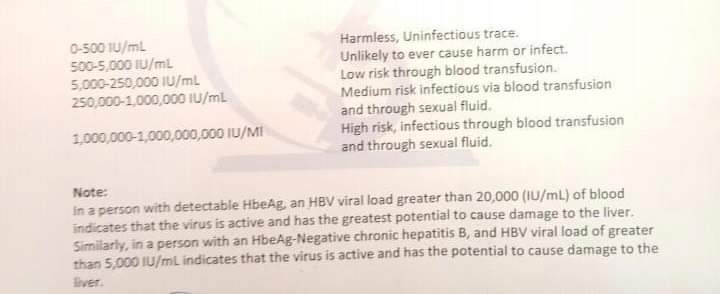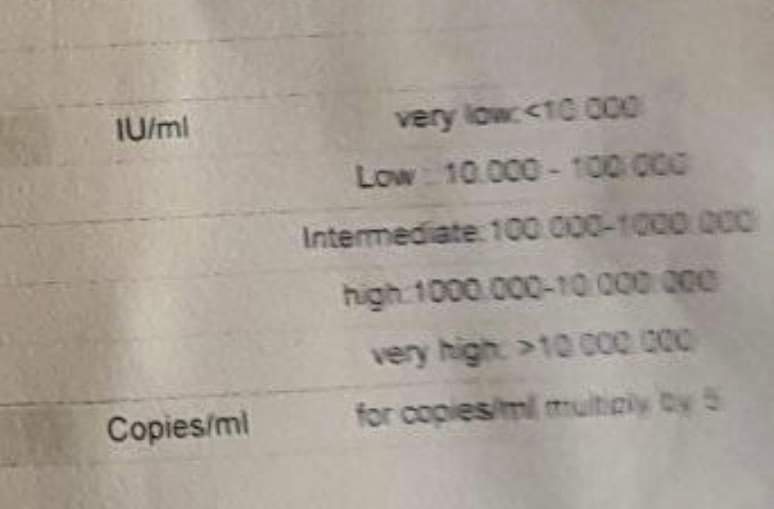So when you’re diagnosed with hepatitis B do you go through all those phases to where you at now or you just have one when you’re diagnosed and that’s what it’s always been at since you had it?
People will generally go through the phases sequentially over the course of their lives.
Thomas
I see there’s no telling it seems how long you stay in those phases so maybe eventually I’ll have to be treated it seems
Dear @Eddie,
The key word in your latest post is “maybe”. Some people progress and need therapy, others do not because hepatitis B is a really complex disease. Some of the rules for who will progress and need treatment and who is relatively unlikely to do so are known, but not all of them. I urge you to follow the monitoring plan established by your doctor. Also note that the treatment recommendations for HBV are very likely to start changing over the next few years (5 years? 8? 10? nobody knows because the pace of drug development cannot be predicted). Therefore, keep asking a lot of questions here and with your doctor!
John Tavis
Hello everyone , I am a bit confused about the term “functional Cure.” And I am not sure where my situation fits.
I found out I was hbsAg positive when I was in college around 30 years ago , now I am in my late 40s now, I likely have gotten it as a baby. I have never needed tx because my HBV DNA had been undetectable.
But last May, I went for a routine check up and my Alt was high at 53 and HBV DNA was 30, with my cholesterol also elevated , I have been eating poorly and not exercising as much (3days per week)
My Hepatologist told me to go on a diet and I did. My BMI went from 25 to 22. I have had LFT and HBV DNA done every 3 months since , and the ALT eventually improved to 22 , the HBV DNA has since returned to undetectable. My HbsAg is positive, but quantitative HBsAg is undetectable.
Sorry for the long story. So was that HBV dna of 30 due to my letting myself go lazy? Which caused weakened immunity? Can I be included with the group of functional cures since the quantitative HBsAg is undetectable or am I still in the chronic inactive hepatitis B group?
Thank you for reading my long story, any input would be appreciated
Rick
Hi Rick and welcome to our community!
The term “functional cure” is indeed misleading for patients. This term is used to describe complete immune control of HBV infection in your liver. This means that in the absence of any antiviral therapy, we cannot detect any evidence of viral replication (HBV DNA) or the production of immunosuppressive subviral particles (HBsAg) in your blood and your liver function is normal. This is an excellent outcome since we know that with this immune control in place, any liver disease (if present) can reverse and the chances of you getting liver cancer not much different from someone who does not have liver disease.
However, even with “functional cure”, inactive (latent) infection resides in your liver. This infection can indeed reactivate in immunosuppressed individuals (this is the problem with the cure part of the term functional cure). Patients with functional cure need to take care of this immune control or they risk reactivation of their liver disease. This is likely what has happened in your case.
You have functional cure when HBV DNA is not detectable, HBsAg is < 0.05 IU/mL by a quantitative assay or HBsAg negative by a qualitative assay and your ALT is in the normal range. Many people have functional cure of HBV without having detectable antibodies to HBsAg and this is not part of the definition of functional cure.
The term " inactive chronic HBV" is reserved for patients with normal liver function who maintain HBV DNA < 2000 IU/mL in the absence of therapy.
Hope this helps.
Thank you Andrew for the clarification on this subject. It really mean a lot for me. And speaking of HCC risk, does anyone else on this forum use the Hep B Reach Calculator?
Based on this Calculator, my 10 year risk of HCC goes to 2 percent when I hit 60.
This large study was done in Taiwan. I am curious if anyone else have used this calculator and how they feel about it .
Thanks
Rick
Dear @LiveWell,
Welcome to the community and thanks for sharing your story.
I agree with the points made by @availlant above and it sounds like your blood results are promising. Well done to you for your efforts in keeping track of your liver health and implementing lifestyle changes that seems to have improved things.
It looks like your HBsAg levels are pretty low to undetectable. If I were you, I’d maintain monitoring to check that your HBsAg tests return a negative value in the upcoming months.
There are some issues with this calculator - it doesn’t include things like fibrosis levels which are known to contribute to HCC risk. It also isn’t applicable for people who are HBsAg-negative, who are at much lower risk of HCC. I am also not sure if it includes people on antiviral treatment, which we know lowers HCC risk.
TT
Thank you Thomas, really appreciate all you do!!
I am in the states and somehow my GI specialist is resistant on checking the HBsAG quant, she would only check HBV DNA level, but yes I check that along with AFP and LFT every 6 months.
I agreed that the REACH B calculator has a few short comings. It does not include tx with antivirals which definitely lowers the HCC risk. And it does not include factors such as Atorvastain exposure , whether you have Diabetes, lipid profiles or regular exercise. Which all can affect HCC risk. But I believe that this is the best calculator of its kind available right now, as it is based on a large human population study. I believe that Tenofovir was not wildly available when this study was done.
As always, I appreciate your time and input
Rick
Dear @ThomasTu and @HealthExperts
I would like to ask about the attached screenshots regarding HBV viral loads.
If the viral load is low, let’s say 1,140 IU/ml, why is this viral load unlikely to infect others via blood or sexual fluids?
Is it because the stated amount of virus is not strong enough to make the other person sick?
Thank you, very much.
I do not see the screenshot but any HBsAg positive carriers is infectious. The level of infectivity is mainly reflected by serum HBV DNA levels, the lower are the levels the lower the infectivity. HBV DNA levels of 3 logs are at intermediate/low risk for non vaccinated individuals. Risk factors are also relevant
PL
Prof. Pietro Lampertico, MD, PhD
Full Professor of Gastroenterology
Chief, Gastroenterology and Hepatology Division
Foundation IRCCS Ca’ Granda Ospedale Maggiore Policlinico
Director, CRC “A. M. and A. Migliavacca” Center for Liver Disease
Department of Pathophysiology and Transplantation
University of Milan
Via Francesco Sforza 35
20122- Milan
Italy
Phone +390255035432
Fax +390250320410
Email pietro.lampertico@unimi.it

In the screenshots for hbv viral load:
0-500 iu/mL - harmless, uninfectious trace
500-5,000 iu/mL - unlikely to ever cause harm or infect
5,000-250,000 iu/mL - low risk through blood transfusion
250,000 - 1,000,000 iu/mL - medium risk, infectious via blood transfusion and sexual fluids
1,000,000 - 1,000,000,000 iu/MI - high risk, infectious via blood transfusion and sexual fluids
Hello, sir. Thank you for your response. Could you please convert 3 log into IU/mL? I’m quite confused with log. Thank you so much.
1500 iu/mL is 3 logs iu/ml…

La Statale per il futuro
Salute, transizione digitale, sostenibilità
Il tuo 5xmille ai nuovi progetti di ricerca dell’Università degli Studi di Milano
Codice fiscale: 80012650158
HI @Jodie_2nd,
Just for the patient community at large:
HBV DNA and HBsAg can exit at quite high levels: greater than 10,000,000 IU/mL for HBV DNA and greater than 100,000 IU/mL for HBsAg.
Although 90% reduction or 190% increase in these levels are indeed big changes numerically, they usually have little impact on disease or the response to antiviral therapy.
For this reason, we convert the LINEAR numbers into LOGARITHMIC numbers to make communicating changes in viremia more meaningful.
1 IU/mL = 0 log IU/mL
10 IU/mL = 1 log IU/mL
100 IU/mL = 2 log IU/mL
1000 IU/mL = 3 log IU/mL and so on…
in the case above, 1500 IU/mL = 3.12 log IU/mL
So in general, 1-2 log declines in virema from baseline during therapy or in monitoring HBV infection (HBV DNA or HBsAg) are not really very strong changes and are not associated with an ability to stop therapy.
Undetectable HBV DNA usually means 5-7 log decline from baseline values.
Undetectable HBsAg usually means 4-5 log decline from baseline values.
Best regards,
Thank you, sir. Is 1,500 IU/ml infectivity applicable for both blood and sexual fluids? I mean, intermediate or low risk via these routes? Thank you, sir.
Oh, I see. Thank you, sir @availlant . What if the HbsAg decreases slowly by less than 1 log? Does it mean the body is undergoing seroconversion?
For example, based on my HbsAg monitoring for this year:
I started at 72 iu/ml then after a few months it became 33 iu/ml then as of the recent result, it’s 29 iu/ml. Is there a chance that my HbsAg will become undetected?
Thank you.
Dear @Jodie_2nd ,
Are these results measured during ETV or TDF / TAF therapy?
Although your initial HBsAg is quite low, the last two readings appear stable. There is always a chance that you might clear HBsAg but it is difficult to comment beyond this (sorry!)
Best regards,
Hello sir, I don’t take any therapies or medications.
I’ve been chronic for 15 years. I only started monitoring my hbv and hbsAg two years ago. I was surprised when my HbsAg became 200+ iu/ml back then. And as of this year, HbsAg is now on two digit quantity (29 IU/ml). I still don’t have HbsAb tho.
If let’s say I cleared up my HbSAg miraculously, is there a chance that it will come back since I still don’t have HbSAb?
Thank you,sir.

